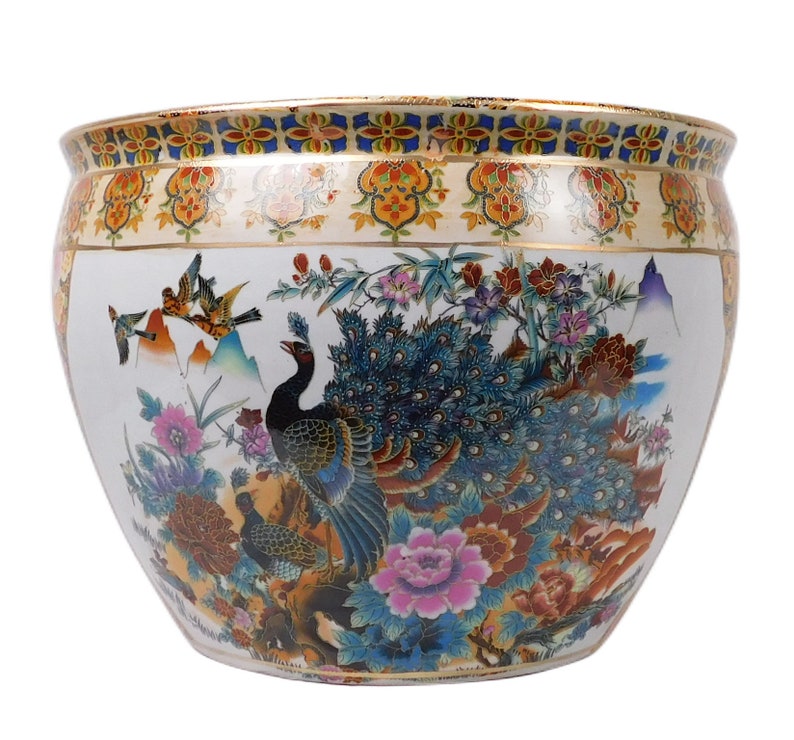The Japanese Fish Bowl Planter
While browsing a local nursery, an unusual planter caught my eye - a decorative glass fish bowl designed for plants rather than pets.

Intrigued by its novelty, I decided to give the "Japanese Fish Bowl Planter" a try. Several months later, here are my impressions of using this unique container garden option.
What is the Japanese Fish Bowl Planter
This planter is crafted from thick, frosted glass in a rounded cylindrical shape resembling an ornate fish bowl. Sizes range from 8-16" tall with 6-12" openings depending on your desired scale.
The thick glass construction provides durability while maintaining transparency.What sets it apart though is the drainage system.
Rather than a typical drainage hole, it uses a narrow slit around the entire base that allows water to slowly seep out over time instead of all at once. This self-watering functionality is stylishly concealed beneath a moss green felt ring.
Additionally, a small pebble tray is included at purchase to elevate the bowl and provide further drainage/aeration for roots. Overall, it combines the visual interest of a traditional fish bowl with practical gardening elements for optimal plant growth.
Choosing My Bowl
I opted for the 12" model which seemed a balanced size for most indoor settings. It has a 9" opening that allows for good root space without taking over available surfaces.
The thick glass dimension also ensures structural stability without risk of breakage. I loved how the frosted material kept contents private while still allowing plenty of natural light transmission.
It was ready to become a statement water feature, terrarium, or planted garden showpiece. I couldn't wait to see it filled with greenery!
Getting Started
After washing my new glass bowl, I filled the pebble tray reservoir with stones and placed the drainage ring into position above it.
Next, I layered damp sphagnum moss for humidity followed by a mix of potting soil, perlite and sand. This allowed the desired self-watering function.
Then I nestled a few dwarf mondo grass clumps, miniature rosemary cuttings and trailing ivy into the soil.
A few sprigs of colorful lichens and small pebbles on top finished the look. It came together so naturally while showing off all the materials wonderfully.
Observations Over Time
Within a few weeks, new growth already emerged all over the bowl as it thrived in the ideal self-contained environment.
I found myself admiring it from all angles daily, mesmerized by its serene appearances changing with the light.
My plants expanded quickly without overflowing their boundaries, perfectly balanced. Their green mass helped regulate humidity inside naturally.
No matter how busy life got, this beautiful bowl required minimum maintenance thanks to its smart design.
My favorite times were evenings with it illuminated beside me, its calming presence and fluid balance bringing a sense of Zen-like peace. It truly had become the ideal low-effort indoor garden scene I was after.

Care and Maintenance Tips
The Japanese fish bowl planter is extremely low maintenance for the benefits it offers. I've found:
- Top off pebble tray weekly to keep reservoir level
- Check soil moisture every 5-10 days, water sparingly
- Trim any overgrown parts seasonally for shape
- Wipe outer glass as desired with dry microfiber cloth
- Replace moss/soil annually or as needed for refresh
Simple tasks like occasionally rotating the bowl also ensure even sun exposure. Overall the closed system approach means very light-touch care while creating thriving indoor 'jungles'.
Best Plant Matches
Some top species I've found thrive especially well are:
- Air plants/tillandsia
- Creeping fig varieties
- Fittonia ('nerve plant')
- Philodendrons/pothos
- Peperomias
- Small ferns
- Hydrocotyle ('pennywort')
- Mini tropical shrubs/herbs
- Moss varieties
- Dwarf jade/succulents
The humidity, moisture and constrained roots suit trailing vines, mosses and foliage plants best. Color and texture combinations lookbeautiful inside too.
Commercial Insights
At $40-70 depending on size, this planter isn't the most affordable option. However, I believe the price is more than reasonable when you consider:
- Sturdy glass construction that will last for years
- No need for planters, soil or hardware separately purchased
- Low maintenance self-contained ecosystem saving time/effort
- Ability to observe plant growth and changes firsthand
- Attractive design transforming any space it is placed
Compared to the cost of soil, containers, and pebble trays bought individually, it pays for itself quickly. Plus, the mental wellness benefits of its living art display further increase its value in my opinion.
It lasts far beyond single plant seasons too by simply replenishing soil. Overall I think it offers excellent savings and enjoyment over time.
Where to Purchase
Some top recommended retailers offering authentic Japanese fish bowl planters include:
- Specialty plant nurseries and greenhouses
- Asian import shops
- Tokyostyleshop.com
- Amazon (sold by well-reviewed brands)
- GlassPassion.com
- Etsy shops specializing in terrariums
For the highest quality and lowest chance of knockoffs, I suggest seeking out family-owned nurseries that stock a variety of sizes in person if possible. Online verified retailers are also usually very reputable options.

In conclusion
This unique planter exceeded all my expectations and goals for an easy yet impactful indoor garden creation. I’ve treasured observing its complexity develop over the past months care of its intelligent self-watering system. The soothing atmosphere it contributes to any space has been invaluable as well.
If you’re searching for a low-effort, living work of art to brighten your home, I wholeheartedly recommend the Japanese fish bowl planter. Its rewards are well worth any initial investment. Hands down, this has become my new favorite way to garden indoors!
